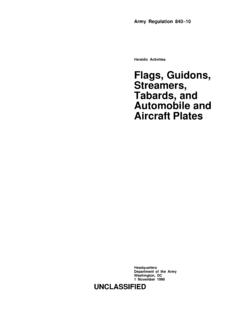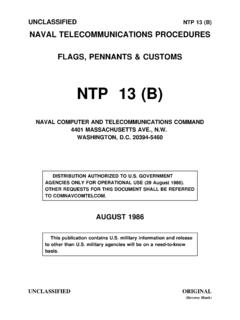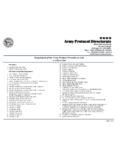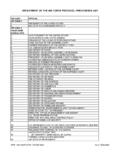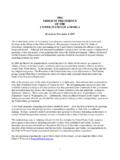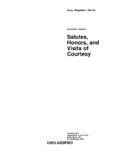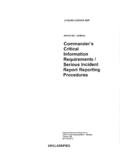Transcription of Personnel—General A Guide to Protocol and …
1 Department of the ArmyPamphlet 600 60 Personnel GeneralA Guide toProtocol andEtiquette forOfficialEntertainmentHeadquartersDepa rtment of the ArmyWashington, DC11 December 2001 UNCLASSIFIEDSUMMARY of CHANGEDA PAM 600 60A Guide to Protocol and etiquette for Official Entertainmento Rewords social calls (chap 1).o Deletes general guidelines in introductions and adds the word "gender" (chap1).o Rewords completely engraved invitations (chap 2).o Corrects to state that a printed invitation usually starts with the host of anevent on the first line (chap 2).o Adds that telephone Invitations may be used where there is extremely shortnotice (chap 2).o Adds an explanation of telefax invitations (chap 2).o Changes reply of a married couple to a formal invitation when only one canattend (chap 2).
2 O Removes informal invitations and corresponding figure (chap 2).o Removes reference to a sample reception and receiving line checklist (chap3).o Changes reference to carpet at receiving line (chap 3).o Adds guidance regarding a woman standing at the end of the receiving line(chap 3).o Clarifies guidance regarding position of receiving line in a room (chap 3).o Removes guidance of alphabetical flag display (chap 3).o Adds the order of precedence of Service flags (chap 3).o Changes guidance regarding display of personal flags of attendees (chap 3).o Removes guidance regarding formal dinners and exceptions (chap 3).o Adds guidance regarding an interpreter at a dinner (chap 3).o Adds guidance regarding toasts and prisoners of war (chap 3).
3 O Changes "musical and cannon salutes" title (chap 4).o Adds samples for sequence of events of retirement, award, promotion, andretreat ceremonies (chap 4).o Expands guidance on finials (chap 4).o Changes guidance regarding streamers facing forward (chap 4).o Revises guidance explaining the need for rules of precedence (chap 5).o Removes reference to precedence among married, divorced, widowed, andunmarried women (chap 5).o Revises the example of visiting official (chap 5).o Consolidates guidance regarding seating of foreign visitors (chap 5).o Clarifies guidance regarding seating and persons on promotion lists (chap 5).o Changes seating of Sergeant Major of the army to follow that of the Director ofthe army Staff, a four-star general, or an equivalent rank civilian (chap 5).
4 O Adds table 6-1 titles and forms of address for Vice President, Govenor of aState, warrant officer, and enlisted personnel (chap 6).o Changes the guidance regarding menu restrictions by adding table 7-1 (chap7).o Places updated references list in appendix Places official toasts in appendix Updates the precedence list and places it in appendix developed among nations in the course of their contacts with one anotherdefine the essence of Protocol . Protocol is the combination of good manners andcommon sense, which allows effective communications between heads of state and theirrepresentatives. It is not static. Rather, it is an evolving science that, over the years, haslost much of its traditional pomp and picturesque ceremony.
5 Changes in acceptedprotocol, however, are best left to the highest policy-forming officers in the Departmentof State. Errors in Protocol may be mistaken as a signal of a change in the internationalclimate. Persons using this pamphlet are cautioned that unauthorized innovations inprotocol, however well intentioned, are encompasses the body of manners and forms prescribed by custom,usage, or authority. It is accepted as correct behavior when people deal with oneanother. etiquette preserves respect for the rights and dignities of others. In short, etiquette represents good manners. Today, many of the old established customs areblended with less restricted ways of life of entertaining with little or no help, incommunicating with others, and in coping with everyday problems that once werehandled by a staff.
6 The full integration of women and divergent cultures into theServices brought more changes. Service people now have a more knowledgeable way oflife. Still, as in bygone years, there are certain rules to be followed in order to reach thegoal of easier, gracious with any rule of the road, a charted course will get you to a specific place at agiven time for a certain occasion. Proper etiquette is not artificial. It is a practical set ofrules. When learned, these rules save time that would be wasted in deciding what isproper. etiquette helps people proceed with the more important phases of social intent of this pamphlet is to provide you with the basics of proper Protocol andetiquette.
7 Using this information as a foundation, you should feel at ease in such mattersas calling cards, introductions, invitations and responses, official dinners, seating andprecedence, forms of address, and arranging visits for important visitors. With practice, Protocol and etiquette will not be difficult but will be instead a natural, courteous wayto properly greet and entertain civilian and military visitors and of the ArmyWashington, DC11 December 2001 Personnel GeneralA Guide to Protocol and etiquette for Official Entertainment*Department of the ArmyPamphlet 600 60 History. This informational pamphlet is arevision. The publication was last revisedo n 1 5 O c t o b e r 1 9 8 9 , a u t h e n t i c a t e d b yorder of the Secretary of the army by CarlE.
8 V u o n o , G e n e r a l , U n i t e d S t a t e s A r m y ,Chief of Staff; Official: William J. MeehanII, Brigadier General, United States army ,The Adjutant This informational pamphletpresents current Protocol This informational pam-p h l e t a p p l i e s t o t h e A c t i v e A r m y , t h eA r m y N a t i o n a l G u a r d o f t h e U n i t e dStates, and the United States army Re-serve. During mobilization, procedures inthis publication may be modified by and exception proponent of this informational pam-phlet is the Deputy Chief of Staff of theArmy. The Deputy Chief of Staff of theArmy has the authority to approve excep-tions to this pamphlet that are consistentwith controlling law and regulation.
9 Theproponent may delegate the approval au-t h o r i t y , i n w r i t i n g , t o a d i v i s i o n c h i e fwithin the proponent agency in the gradeof colonel or the civilian Improvements. Those whou s e t h i s i n f o r m a t i o n a l p a m p h l e t a r e i n -vited to send comments and suggested im-p r o v e m e n t s o n D A F o r m 2 0 2 8( R e c o m m e n d e d C h a n g e s t o P u b l i c a t i o n sand Blank Forms) directly to the DeputyChief of Staff, ATTN: DACS DSP, 200A r m y P e n t a g o n , W a s h i n g t o n , D C20310 200 Distribution. This publication is availa-ble in electronic media only and is in-tended for command levels B, C, D, andE for Active army , army National Guardof the United States, and the United StatesArmy (Listed by paragraph and page number)
10 Chapter 1 Visits and Introductions, page 1 army customs 1 1, page 1 General rules 1 2, page 1 Official calls 1 3, page 1 Social calls 1 4, page 1 Introductions 1 5, page 1 Chapter 2 Invitations, page 1 Formal engraved invitations 2 1, page 1 Semi-Engraved invitations 2 2, page 2 Formal handwritten invitations 2 3, page 3 Telephone invitations 2 4, page 3 Telefax invitations 2 5, page 3 Replies to formal invitations 2 6, page 3 Withdrawing an acceptance or invitation 2 7, page 5 Informal invitations 2 8, page 5*This pamphlet supersedes DA Pamphlet 600 60, dated 15 October PAM 600 60 11 December 2001iUNCLASSIFIEDC ontents ContinuedChapter 3 Official Entertaining, page 8 army customs 3 1, page 8 Formal receptions and receiving lines 3 2, page 8 Display of flags at military receptions and dinners 3 3, page 9 Seating arrangements 3 4, page 10 Formal dinners 3 5, page 11 Toasts 3 6, page 12 Chapter 4 Ceremonies, page 20 Rendering honors 4 1, page 20 Sequence of events 4 2, page 21 Display of flags 4 3, page 22 Seating 4 4, page 23 Chapter 5 Order of Precedence, page 23 Determining precedence order 5 1, page 23 Individuals frocked to a higher grade 5 2.


